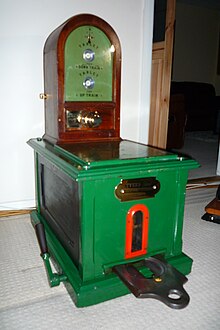Token (railroad)

As a token , tie rod , signal bar , track rod or stick is called an object in the iron and tram being whose possession for driving a single-track right track section.
distribution
Token systems for train protection are or were widespread in the British Isles and in the former British colonies.
Staff and ticket system
In the oldest form of tokens in the form of a baton (English: staff ) made of wood or metal, the with the name of the route section is labeled. The engine driver receives the baton from the station master or signalman at the exit station and returns it to the destination station. Since there is only one token for each single-track route section, collisions are effectively prevented - provided the system is used correctly.
use cases
- Innsbruck low mountain range railway
- Kirnitzschtalbahn
- Spree tunnel Stralau – Treptow
- Berlin East Railways
- Selfkantbahn
- Tram Goerlitz
Obviously, it is disadvantageous that two trains cannot travel one behind the other in the same direction, but the rod must first be brought back to the starting point by a train traveling in the opposite direction. One solution to this problem is that all trains traveling in the same direction except the last one, instead of the staff, are given a written permit; For safety reasons, the train driver has to make sure that the staff is still in the exit station when he receives the driving license. The baton is given to the last move of the group; only then may a train run in the opposite direction. This procedure is known as the staff and ticket system . Further solutions are shown under tension rod systems and the Kirnitzschtalbahn.
Electric Token Block
With this system, the tokens are stored in two devices at the beginning and at the end of the single-track section of the route. The tokens are shaped like a round disc, a key or a stick. The devices are electrically interconnected and there can only be one token outside of the devices at a time. So that several trains can run one behind the other in the same direction, there are several tokens in each machine. The oldest design of the Electric Token Block is the Electric Tablet System , which was still used in Sri Lanka in 2012 . Another widely used system is the Webb & Thompson Electric Train Staff .
Radio Electronic Token Block
With this system, the token is no longer an object, but an encrypted signal that is transmitted by radio from a central control center to a computer in the driver's cab of the vehicle . The computer in the control center checks that only one token is issued for each section of the route and that it is withdrawn again after driving through the single-track section.
literature
- LTC Rolt: Red For Danger . 3rd edition, revised and supplemented by GM Kichenside. David & Charles, 1976, ISBN 0-7153-7292-0 , pp. 140-141 .
- Stanley Hall: BR Signaling Handbook . 1st edition. Ian Allan, 1992, ISBN 0-7110-2052-3 , 21: Working of Single Lines, pp. 68-73 .
Web links
- Single Line Operation ( English ) Railway Technical Web Pages. June 13, 2013. Retrieved July 10, 2013.
Individual evidence
- ↑ Kirnitzschtalbahn - kirnitzschtal.org. In: saechsische-schweiz-touristik.de. Retrieved June 7, 2018 .
- ↑ limited preview in the Google book search
- ↑ Kirnitzschtalbahn - kirnitzschtal.org. In: saechsische-schweiz-touristik.de. Retrieved June 7, 2018 .
- ^ Gyan Fernando: Rozelle: A quaint little Railway Station. In: Railway Journeys and other railway articles. March 19, 2012, accessed May 24, 2016 .

